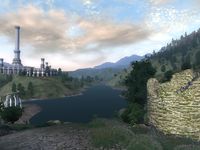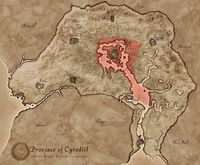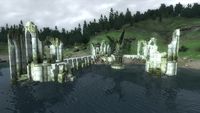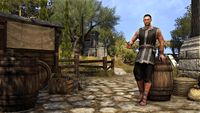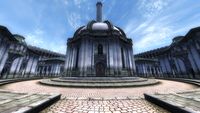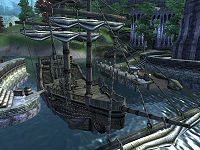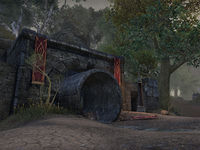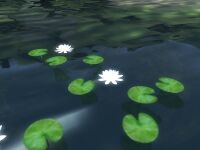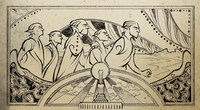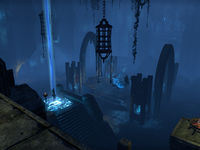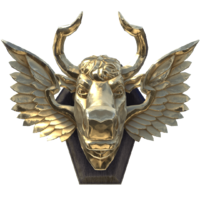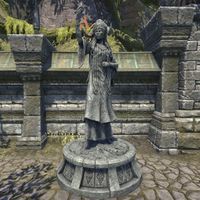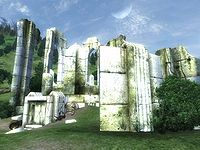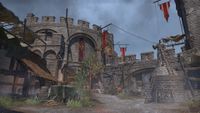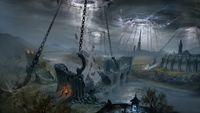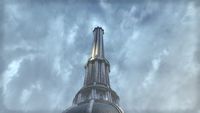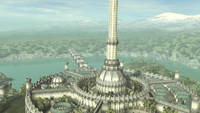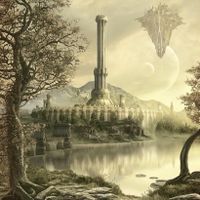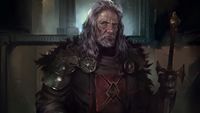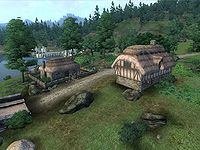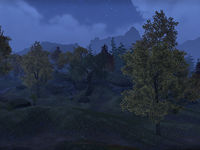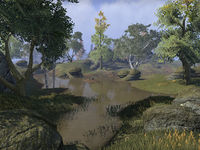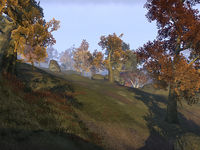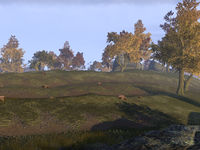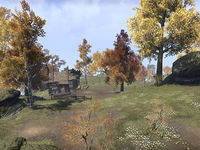Lore:Heartlands
| Heartlands | |
|---|---|
| Type | Region |
| Continent | Tamriel |
| Province | Cyrodiil |
| Subregions | City Isle Upper Niben |
| Demonym(s) | Heartlander |
| Appears in | Oblivion, ESO |
The Heartlands (also known as the Valley Heartland)[1] are the central lowlands of Cyrodiil; a grassland region surrounding Lake Rumare, as well as the Upper Niben and Niben Bay.[2][3] At its center is the Imperial City, the largest settlement in the province and the seat of Empires, from the original Ayleid Empire[4] to the Cyrodilic Empires of Man.[5]
The Heartlands and the Imperial City are part of the greater Nibenay region,[6] more specifically the Nibenay Valley that encapsulates the rest of the Niben River and reaches as far south as Blackwood.[3][7][8] The Heartlands are geographically bordered by the Great Forest from the north, south, and west, the Nibenay Basin to the east, and the central Nibenay Valley around Bravil.[8]
Society and Geography[edit]
Demographics[edit]
The local Imperials are known as Heartlanders, an apt name for this subsection of Nibenese that live in and around the Imperial City. They are also called Imperial Heartlanders[9] and Nibenean Heartlanders.[10] There is a distinction to be made between those that live inside and outside the Imperial City. Much of what lies outside are small communities and farms like Aleswell, Pell's Gate, and Weye.[11] Additionally, other lower-class citizens live in the Waterfront District southwest of the city's wall on Lake Rumare.[2]
The Imperial City's grandeur and scope are widely known in literature. From Refayj's famous declaration of the "city of the Cyrodiils"[3] to even the writings of Plitinius Mero (The Real Barenziah)[12][13] and born Imperial City native Enric Milres. It is said that even a beggar here is a man living in a palace. But from the latter's own words, albeit backhanded, the people have a great sense of importance from living so close to the Emperor and on the well-kempt, white-marbled streets.[14]
This disparity is seen across the greater Nibenay region, where the merchant nobility, temple priests, cult leaders, and ancient battlemage aristocracy stand above the working class.[3] A notable Heartlander family is the Carvain family who ruled County Bruma in the late Third Era.[10][15] Furthermore, some people take up customs from the Akaviri,[3] namely the Tsaesci[16][17] that were once prevalent under the Second Empire.[3] Colovians from the west can also be found in the Heartland, however, most of them come from the Imperial Legion military,[18]:Part 2, Chapter 7 who are headquartered in the Imperial City Prison.[19]
The Imperial City, as the epicenter of the Empire, is cosmopolitan.[5][12] Upon his ascension to the throne, Reman I incorporated aspects of the Nibenay, Colovia, High Rock, and the recently defeated Akaviri to turn the Imperial City and his Empire of Man into a worldly center of civilization.[5] This extended to the Third Empire as well. In its early years, Redguards were seldom seen, at least compared to the Bretons, Dunmer, and Nords. The famous author of Redguard history and verse, Destri Melarg had to adopt his surname to fit in with these other cultures when he first arrived in 3E 39.[20] In at least the first half of the Second Era, there was also a small, yet notable community of Bosmer in the Waterfront District.[21] Many Argonians come to the Imperial City to make money by working the waterways and water-based trades.[22]
Before it was taken over by the Imperials, the White-Gold Tower and the surrounding city was the seat of the Ayleid Empire, a vast nation across modern-day Cyrodiil that comprised of the eponymous Ayleids, also known as the Heartland High Elves.[23][24] The enchanters of this period were considered some of the most clever and prodigal in the craft.[25] When the White-Gold Tower was established, trade flourished in central Cyrodiil and especially south in the Niben Bay, where it became one of the Ayleid Empire's most active and secure regions.[26][27] Up north in the Heartlands, several city-states sprung up around it, whether it was around Lake Rumare like Fanacasecul, or further out like Belda and Culotte.[2]
Some of them hold dark, ancient secrets and history, like Sercen's "gut-gardens"[23] and Nagastani, which supposedly held some evil power that left the land around it dead.[28] Perhaps the most infamous city-state was Abagarlas, a former city of mercenaries and center of worship for Molag Bal. Its ancient history is tied to a rival city of Meridia known as Delodiil, which was also located in the Heartlands. But while Abagarlas' ruins remain underneath City Isle, Delodiil's location and ruins are completely lost to time.[29]
Modern translations of what remains of the Udhendra Nibenu, a Merethic Era epic of Topal the Pilot's explorations indicate that before the Ayleids lived in the Heartlands, there was a race of Bird beastfolk that has since gone extinct. The fourth fragment of the Udhendra Nibenu remains one of the only sources of their existence. The Third Era scholar who translated it, Florin Jaliil believed that their extinction came from an encounter with the "cat demons" mentioned early in the text.[26]
Culture and Industry[edit]
Culturally, this region is distinguished from other places as the Heartland Empire[30] and is considered the agricultural breadbasket of Cyrodiil, as is the rest of Nibenay Valley.[11] Many of its locals outside the Imperial City farm to sustain themselves and help feed the province at large.[31] When it was still an active settlement, Sancre Tor was supplied with goods by the Heartlanders.[32] One of their primary exports is rice, which is harvested by thousands of workers in the flooded fields. Other main exports include textiles and rare treasure goods like hide armor, moon sugar, and ancestor silk.[3]
Under the Alessian Order's rule, the Nibenese were forced to become merchants and thus created a merchant-based society. With eastern Cyrodiil's river-based society, a large trade network was established across Lake Rumare and the Nibenay's rivers. In time, they turned the Imperial City into the wealthiest city-state in the land and outlived the order by years. Import comes from a myriad of sources, either locally,[3] like the people of Weye[18]:Part 1, Chapter 2 or beyond like outlying territories and friendly inland ports.[3] Even under the Ayleid Empire, the Imperial City had an important part in their trade system. Ancient cities as far as Ceyatatar, Haven and Woodhearth benefitted from it.[33]
As Cyrodiil continued to develop and divide itself between counties, the Imperial City region was recognized under the Imperium,[34][35] otherwise known as County Imperium.[UOL 1] Surrounding Lake Rumare is the Red Ring Road, a major thoroughfare that connects the Imperial City and the Heartlands to the rest of Tamriel.[8][36] Going clockwise, from the north it branches with Skyrim via the Silver Road,[8][36][37] from the northeast with Morrowind via the Blue Road,[8][36][38] from the southeast with Black Marsh via the Yellow Road, from the south with the Topal Bay region and Elsweyr through the Green Road,[8][36][39] from the southwest with Colovia and Valenwood through the Gold Road,[8][36] and from the northwest with Hammerfell through the Black Road.[8][36][40]
Many Heartlanders grew up swimming in Lake Rumare and can easily cross the lake without a boat.[41] But locals usually use small riverboats like ferries and gondolas to traverse the lake, the Imperial City's watery avenues, and its outlying territories.[3] Large vessels that come in from the Topal Bay must switch once they reach Leyawiin,[42] though bigger boats are known to dock on the Waterfront[43] and sail the Niben Bay.[44] Since the Second Empire, many Imperials, especially Nibenay have taken up old Akaviri traditions and customs, and find value in their ancestry. Villagers build paper hako-skiffs with dragon-motifs to wing their dead down the rivers. The Imperial City also takes some inspirations, like its high minaret bridges bearing the same motif or its red dragon symbology coming from Akaviri war mounts.[3]
The Heartlanders, unlike the most staunch worshippers, have a formal, yet disconnected relationship with their gods and spirits. They view them as powerful, yet indifferent to their world. They do not see their relationship as personal, and in turn, not worth appeasing. Cults are primarily a means to socialize. They occupy the same space as economic organizations, unlike the staunch traditions of the Dunmer. The only exceptions to this include the charismatic sub-cults of Akatosh, Dibella, and especially Tiber Septim.[45]
The Septim Dynasty made it a policy to limit cult influences in aristocracy, military, and bureaucratic affairs, and as such, they have played a minor part in both Heartland and Imperial history, save for the Alessian Order of the First Era.[45] That being said, the Nibenese have developed many different cults dedicated to a variety of figures,[3] like Shezarr and a myriad of other deities.[46] Shezarr, the Cyrodilic interpretation of the Elven god, Lorkhan, or the Nordic god Shor is present in early Cyro-Nordic stories of the Heartland, in which he fought the Ayleids on mankind's behalf.[46] Similarly, Morihaus is an ancient cultural god hero of the Cyro-Nords, known for his effort in the slave revolt and help in establishing human control of the Heartlands.[1]
The Imperial City is known as the City of a Thousand Cults.[47] The most famous of these institutes include the Cult of the Ancestor Moth, the Cult of Heroes, the Cult of Tiber Septim, the Cult of Emperor Zero,[3] and the Temple of the One,[12] which was originally created by the Alessian Order around the eponymous spirit, the One[3][48][49] and brought back by Tiber Septim.[12] Some of these cults can involve the daedra and the daedric princes, such as the Dagonic cult; the Brotherhood of Destruction[50] or a currently unknown cult of Sanguine, both from the early Second Era.[51] Heroes of the many past wars have been buried in Memorial Cave, an underground crypt on the eastern shore of Lake Rumare across from the Arcane University.[52]
There is a heavy military presence in the Heartlands as the Imperial Legion is based in the Imperial City Prison,[19] on the northeast side of City Isle.[2] Ruined and abandoned keeps from the Interregnum, like Fort Homestead or Fort Urasek litter the shoreline.[3][2] Some of them in their heyday were large impressive fortresses, connected to the rest of central Cyrodiil through the Transitus Network, an obscure form of magical transportation heavily used in the Three Banners War. Six keeps surrounding the Imperial City were vital for absolute control of the region. Four of these keeps: Alessia, Aleswell, Blue Road and Chalman are located in the Heartlands.[53]
The forts built further south in the Niben Bay were part of the early Second Empire's effort to expand south. Fort Grief, built on an island in the middle of the bay, was designed to protect the eastern shoreline from raiders. But the Empire's rapid expansion effectively made them obsolete as not even the most aggressive Argonian fighters attacked the Heartlands.[54] When the Legion used these forts, they had a special alcoholic beverage known as Shadowbanish Wine to wield night eye and actively monitor the area on cold nights. Though this wine has long gone extinct, fully intact bottles are said to still be hidden in these ruins.[55]
Previously an old Ayleid district, the Arcane University on the southeast side of City Isle was for the longest time, the headquarters of the Mages Guild[56] but throughout its history, it has been the center of magical research and study.[57] Wellspring Grove, a forest on the eponymous island in Lake Rumare use to be tended by the university. They used wood specifically from the grove to craft their staves and later enchant them in their chironasium.[58]
For a time, the Mages Guild was banished from the Imperial City[59] and replaced by the Fellowship of Anchorites, who are more commonly known as the Order of the Black Worm, or the Worm Cult.[60] They were instilled by remnants of the Empire of Cyrodiil, at the time under Empress-Regent Clivia Tharn, a pocket ruler to the King of Worms, Mannimarco.[59]
Underneath the Imperial City and even Lake Rumare is the vast network of underground tunnels and caves called the Imperial Sewers. Originally built by the Ayleids, it is a complex system of sewer drains and crumbling ruins centered around the White-Gold Tower's foundation, the Barathrum Centrata.[61] They are comprised of many subregions, some of which have collapsed over the years.[62] Everything from these obscure recesses to the sewers themself are the source of many rumors throughout the centuries.[63] Entrances can be found across the Imperial City streets and even some homes, but City Isle[64] and the mainland shore has entrances outside the city walls.[65]
Ecosystem[edit]
The Heartlands are a temperate grassland[3][31] consisting largely of small settlements, farms, and woodland reserves for game. Trees from the mostly surrounding Great Forest used to grow in abundance around Lake Rumare but were cut down to support agriculture. Occasionally, foliage is cleared from the nearby jungle during the alternate seasons.[3]
These fertile farmlands feed all of central Tamriel though they frequently experience rain and thunderstorms.[31] The lakeshore also regularly floods and feed into the rice fields. The Upper Niben river mouth is also tainted red from the timni soil of the shore.[3] Ever since the Year of Sun's Death (1E 668), when Red Mountain erupted, tuffs of volcanic ash litter the Rumare shore. They can be an ingredient in a rare, potent wine known as Nirnroot Wine.[66]
When Topal and his crew on the Niben first arrived in the region in the Middle Merethic Era, they were awestruck. In the last fragment of the Udhendra Nibenu, it writes, "For eleven days, they traveled north, until they came to a crystalline lake and eight islands of surpassing beauty and peace."[26] Some of these islands include City Isle; the largest and one which houses the Imperial City, and the two unnamed islands where Wellspring Grove and the Waterfront District are located. Interestingly, the city-state of Riverhold in Elsweyr is the closest to City Isle and thus feels lightly influenced by it.[67]
In and around the valley are several types of flora. Sacred Lotuses and lily pads float around the lake.[68] Along the shoreline, Upper Niben, and small inland lakes are water hyacinths[69] and nirnroots.[70] In patches near the Red Ring Road are ginseng[71] and lavender sprigs.[72] Overgrown on the ruins and Imperial City walls are morning glories.[73] Fly Amanita mushrooms are commonplace in the Imperial City[74] and Cairn Boletes can be found in caves.[75]
Many creatures live in the Heartlands, from the plains and farmlands on the surface to the water and the dark passages underneath. Common creatures such as deers, mountain lions, mudcrabs, and wolves inhabit the countryside,[76][77] as well as some unique species, such as the Brindle Badger[78] and the Heartland River Crab.[79] Even certain domesticated animals are native to the Heartlands like the Butcher's Dog bred to protect farmsteads[80] and the Coon Cat that chases rodents.[81] A breed of bird called Shezarr's Chicken is said to have a more deeper connection to the eponymous God of Man than just the name.[82] Minor sub-races live in the Heartlands wilderness. Goblin especially live in the many caves and even Imperial Sewers of the Heartlands.[83] In the hills on the north and east are ogres and minotaurs stalking the roadways.[76][77]
Many fish species, typically lake water fish live in Lake Rumare,[53] but even though the Imperial Sewers leave it relatively clean,[62] foul water pollutes it and attracts other kinds of fish. The rarest of which include the Pufferfish, the Rainbow Fish, the Runmare Bream, the Sewer Eel, the Quillfish, and the Yellow Perch.[84] A larger, more aggressive variation of the Slaughterfish aptly called the Rumare Slaughterfish also live in the lake.[85] When the Imperial City was caught in the Planemeld, many types of new fish polluted its waterways. These include the Aphotic Batfish, the Blobfin, the Cannibal Lancet, the Flabby Whalefish, the Guiyu, the Glow-Spotted Blenny, the Hatchetfish, the Humpback Angler, the Imperial Loosejaw, the Scabrous Grenadier, the Trapjaw Eel, and the Wen Loach.[86]
Upon his rise in the late Second Era, Tiber Septim offered protection for any remaining dragons. Records from that time talk of dragons encircling the towers of the Imperial City and "river dragons" around the mouth of the Niben, where their scales rust in the water.[3] Some of them like Nafaalilargus fought for the Empire during the Tiber War[87] but despite the promise of sanctuary, they were still hunted and slain.[88]
History[edit]
The Pre-Imperial Heartlands[edit]
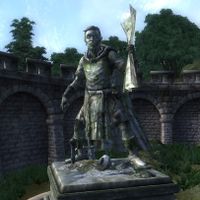
It is generally understood that before man and mer lived on Tamriel, the beastfolk were the sole inhabitants of the continent.[89] The Heartlands were occupied by an ancient race of birdmen whose legacy remains in oral histories and the fragmented ballad of Topal the Pilot, the Udhendra Nibenu.[5][26] A translation of these fragments and notes provided by Florin Jaliil, gives us a look into Topal's journey in the Middle Merethic Era.[26]
As the Niben sailed along the eastern continental seaboard, trying to find their way back to Firsthold, they came across the Topal Bay and at the behest of the crew, traveled north through the Niben River. En route, they witnessed "cat demons" and in eleven days, reached Lake Rumare and the Eight Islands in its center. Topal became enchanted by the beauty of the islands and the birdfolk that lived there. He taught them how to read and write. In gratitude, they named him their lord and offered him the islands as a gift,[26] though some people suggest it was a transaction.[90] Topal made a promise that he would return one day,[26] and while the story of his return remains a mystery, the elves of the distant Summerset Isles did eventually return.[4]
The Heartlands was purportedly a tribute land to the High King of Alinor and eventually, the original Ayleids came to populate it.[4] At its center was the White-Gold Tower, built in emulation of the Adamantine Tower, surrounded by its own city, and with the Chim-el Adabal as its founding stone.[91][92] Because of the distant communications between the Heartlands and the Summerset Isles, and with the buffer that was the developing Bosmer society, they effectively isolated themselves and the White-Gold Tower's settlement became an independent city-state.[4][93][UOL 2]
The Ayleids had splintered themselves from the Aldmer, with some leaving specifically to avoid the strictures of Aldmeri regulations, such as the forbidden worship of daedra. Though most of them celebrated the aedra, daedric cults grew in popularity[94] and in time, overthrew the more conservative aedric-worshipping Ayleids (the Barsaebics) in the Narfinsel Schism.[95] The White-Gold Tower in those years, was known as the Temple of the Ancestors, and on display, were the Ten Ancestors, a set of statues important in Ayleid history and culture.[92] The Ten Ancestors may also refer to a group who worshipped the daedra and wrote the Eleven Edicts.[96]
At the Temple of the Ancestors lived the liege-lord, leader of the Ayleid Empire and its sorcerer-kings.[97][98][99] The person who held this title was Umaril the Unfeathered, the most-favored champion of Meridia, and who possessed the divine bloodline of the Ada.[98][100] Though he was deeply connected to the daedra lord, the many cities built in and around the Heartland had their own patron daedric prince. Abagarlas, for example, was a city that worshiped Molag Bal while its rival Delodiil, though it held many gods like the Divines in reverence, was a place that mainly venerated Meridia.[29]
Abagarlas' king, Anumaril was jealous of Delodiil's chapels of light, and built an even larger chapel and crude shrine for his patron. But when Delodiil seemed unimpressed and its King Cenedelin deemed it pitiful, King Anumaril became furious and wanted nothing but their destruction.[29][101] By using the Mortuum Vivicus, Anumaril planned to drain the life out of Delodiil and led an army of undead to the city. Through Meridia's warnings, King Cenedelin sent knights to destroy the Vivicus and established his defense at home.[102]
These knights cut through Abagarlas and slayed the royal family, except for Anumaril.[102] Before they could destroy the Mortuum Vivicus, Molag Bal ripped it back into Coldharbour.[103] Meridia then destroyed Abagarlas with her righteous lightning, casting it down where its ruins remain since.[102] Anumaril and his horde marched onto Delodiil but found the city had completely vanished. Hearing cries from back across the valley, he returned in haste to Abagarlas and found it destroyed, with the shadows of the dead burnt into its walls.[29]
From this time, the Ayleids were notorious for their use of slaves and the pleasures they derived from them. The elves herded Nedes and other humans from across the Nibenay, like the Al-Gemha, the Kothri, and the Men-of-'kreath. When they were not toiling in arduous work, they were made subjects in strange art tortures, like in Sercen[23] and Fanacasecul.[104] For these humans, the Ayleid Empire was where they knew no freedom. They were denied family and even a name, the latter of which was only kept to themselves.[23] Upon their initial arrival, they were reviled by the widespread daedric worship, with some believing in the present day that the hatred of daedra originated here.[94]
Early History[edit]
As foretold by the Moth Priests, the Ayleid Empire's downfall came from their own hubris and lack of attention toward the Nedes.[91] The Alessian Slave Rebellion, from 1E 242 to 243 was a monumental moment in not just Cyrodiil's history, but marked a shift in the continental power structure, placing man on top. The Nedes who became the present-day Imperials revolted,[5] and leading this movement was the slave commonly known as Alessia. From her holy city of Sancre Tor, she received the divine inspiration for the rebellion from Akatosh.[32][105]
At her side were Morihaus; the Winged-Bull, and Pelinal Whitestrake; the Star-Made Knight.[106] The conflict culminated with the Fall of the White-Gold Tower; marked as the historical end of the Ayleids.[100][107] Because of an earlier attack that left Morihaus incapacitated, Pelinal yearned to fight Umaril despite Alessia's decision to delay an attack and went straight for the tower.[108]
As the following Nedic army stormed the tower, the Ayleids made a pact with Meridia's Auroran warriors. They were summoned to fight with them, and they named Umaril their champion. For the first time since the war, Pelinal was challenged, by Umaril[98] in the shadows of the tower. From there, Pelinal battled many Aurorans and the remaining sorcerer-kings until the liege-lord appeared before him. In a heated battle, Pelinal emerged victorious but the vengeful Ayleid kings attacked at once and tore him into eighths. As the legend goes, Morihaus rammed into the tower and shook it to its core. The battle had been won and the Ayleids, so few in numbers, left the Heartlands.[109] Morihaus has since been known as the Taker of the Citadel and became an ancient cultural hero-god for the Cyro-Nords.[1]
Before they left, the Ayleids left Pelinal's head in the White-Gold Tower's throne room, where it was founded by Morihaus.[14][109] They were also able to take the Ten Ancestors before the attack and secure them across various settlements, such as Culotte and Vilverin. But with the elves gone, the humans took over the settlement and built the present-day Imperial City over the ruins.[92] After the Fall of the White-Gold Tower, Alessia was quick to proclaim herself the first Empress of Cyrodiil and took up rule in the White-Gold Tower.[46][89][110]
Alessia received three visions.[105] The second one came from a visit to an old Ayleid shrine beneath the Imperial City. Her followers then tore it down and built the Dragonfire Cathedral,[111] perhaps the city's greatest kept secret.[112] It contained the Sublime Brazier, which legends claim reaches to the very center of Nirn and once lit the Dragonfires that protected the world from Oblivion.[113] As the Empress, Alessia also assumed the mantle of High Priestess of Akatosh, and to accommodate her subjects that still venerated the elven aedric pantheon and her Nordic allies, she created the Eight Divines pantheon out of their similar beliefs.[46] But in questioning elven rule, Alessia brought about the worship of a singular god, and the cult that rose around it became known as the Alessian Order.[3]
The Ayleid Diaspora and the Alessian Order[edit]
The Fall of the White-Gold Tower marked the end of the Ayleid Empire and the beginning of the Late Ayleid Period. Some allied Ayleid kings, most of whom were aedric worshippers, were allowed to rule vassal states. But the daedraphilic Ayleids were forced to escape Cyrodiil in what is now called the Ayleid Diaspora. Most of them successfully fled, with the clans of Vilverin for example kept largely intact, but others were given no chances.[95][107] One of the surviving refugees included King Anumaril, formerly of Abagarlas, who found his way to Elden Root in Valenwood.[91]
In time, the Alessian Order became much stronger and imposed greater power over the Empire.[3] The Imperials, still feeling resentment toward the Ayleids, eventually targeted the Ayleid vassals and drove them out of Cyrodiil as well.[107] This contempt began to spread as the Alessian Order took on more power. According to the research of the eminent scholar of beastfolk, Nonus Caprenius, the order targeted the minotaurs and even their second Emperor Belharza.[114] But other contemporary scholars detest this specific writing for connecting the minotaurs to Alessia and contradicting the purported facts about Belharza's death.[115]
In their push for even more power, the Alessians came into conflict with the Colovian Estates. The West enjoyed some autonomy from the Alessian East,[3] but the latter saw a window of opportunity to assume control. In 1E 478, a great plague passed through Cyrodiil but was especially concentrated in Colovia. One of its victims was the royal family in Skingrad and King Mhorus Larich. The oldest living child, Dorald was an Alessian priest in the Imperial City. Upon taking the throne, his first decree was to cede the independent kingdom to the Empire. His younger brother, Rislav was able to usurp his throne and do battle with the Alessian Army led by Emperor Gorieus. Though it took substantially longer to reach it, this battle is seen by some as the end of the Alessian hegemony.[116]
Even with this failed attempt, the Colovian West and the Nibenean East were considered part of one Empire by the late First Era.[117] The War of Righteousness however, ultimately sealed the Empire's fate and ended it by 1E 2331. While King Desynan of Skingrad left a puppet ruler to the Imperial City,[118] the surrounding valley reverted to a mercantile magocracy, distancing themselves from the west.[3] Cyrodiil degraded as time passed. Local warlords assumed control of the Heartlands, and mages and false moth-princes of the east wallowed as no one sat on the Ruby Throne.[117][118]
The Heartlands in the Second Empire[edit]
As the Remanada goes, a shepherdess named Sed-Yenna came from Sancre Tor, carrying a small child named Reman to the White-Gold Tower, and placed him on the Ruby Throne. He then spoke as an adult, "I AM CYRODIIL COME".[117] In the late First Era, the First Akaviri Invasion took place and traveled west toward Cyrodiil. Reman united the Nibenay Valley's army and the Colovian West, to create the Army of Reman, and combatted the threat at Pale Pass. In the end, Reman defeated the Akaviri and with their help, created the Second Empire of Man.[3][119] Through the combination of his allies and the Breton customs of High Rock, he turned Cyrodiil and the Imperial City into a cosmopolitan metropolis.[5]
People nowadays believe the neighboring kingdoms quickly recognized his reign, but this was not entirely the case as the borders were not reliably secure. Many Imperial forts and strongholds were built to fight raiders and bandits,[120] and protect the Heartlands and Niben Bay.[54] Especially in the Trans-Niben region, where the warlike clans of Anequina stalked northern Blackwood, and where the presence of nearby unconquered Black Marsh was felt. Fort Grief was built on the mouth of the Silverfish River to protect the eastern Niben Bay but with how quick Reman's expansion was, it lost purpose and was largely abandoned in 1E 2900.[54][120]
The Akaviri were given amnesty by Emperor Reman and integrated themselves into Tamrielic society, predominantly living in the Imperial City. From there, they influenced much of the city and province's culture and administrative infrastructure. Many of their distinct dragon motifs could be seen across the Heartlands. One of their biggest contributions was reforming the Imperial Legion, thus giving the Empire the leeway to conquer their neighbors. At the Emperor's side was their advisor, the Potentate who were usually of Akaviri descent.[3] Famously, the Potentate of Emperor Brazollus Dor, Sidri-Ashak was the real administrator to the Empire while the Emperor was elsewhere, usually in his estate near Skingrad.[121][122]
In the late First Era, the Empire was ruled by Reman III, and with his Potentate Versidue-Shaie as his right hand. In 1E 2920, while the two were in the Imperial City, the Crown Prince Juilek was embroiled in the Four-Score War. The Prince and the Imperial Army were stationed in Bethal Gray, a village in the Heartlands near the forest before they traveled east for the Siege of Ald Marak in Morrowind.[123] Despite their victory in the end,[124] the two members of the Reman Dynasty were assassinated by the Morag Tong and without an heir, Versidue-Shaie assumed control of the Empire. In front of the Imperial City, he announced the death of the Reman line and the start of the Second Era.[125]
The Heartlands in the Interregnum[edit]
—Excerpt from the Brief History of the Empire by Stronach k'Thojj III, Imperial Historian
The death of Potentate Savirien-Chorak in 2E 431 led to the fall of the Second Empire. What started was an era of conflict and chaos known as the Interregnum and at its center was the greater Cyrodilic Heartland and especially the Imperial City. Many warlords, bandits, and other malicious factions fought for control of the capital.[5]
A big consequence was the large-scale exodus of Akaviri from the Imperial City. One of these warlords named Attrebus expelled them, and their exodus brought them to the far south in Elsweyr. Those that survived reached Rimmen, where their rulers: King Savlian and Queen Padala granted them asylum in outlying regions like the Rim Territories or northwestern Elsweyr[126][127] (i.e., Reaper's March).[128]
One of the most famous contenders for the Imperial City was Varen Aquilarios. Before his rise, he was a Duke of Colovia, hailing from Kvatch. He was at war with the Longhouse Emperors, the leading dynasty at the time. After his victory in Fort Ash, Varen Aquilarios and his combined forces marched onto the Imperial City and battled Emperor Leovic.[129] With Chancellor Abnur Tharn's knowledge of the Imperial City, they toppled the Reach hegemony and kill Leovic at the base of the Ruby Throne.[59] Varen, however, was not a Dragonborn like the Alessian or Reman Emperors before him, and worked with his closest allies, together known as the Five Companions to find the Amulet of Kings. One of these companions, Mannimarco proposed a ritual involving the amulet and the Dragonfires.[130][131]
But with his necromantic magic, he tricked Varen and his companions, and initiated the Soulburst, temporarily breaking the Liminal Barrier and initiating Molag Bal's invasion of Tamriel, the Planemeld. The prince's dark anchors fell all over Tamriel,[132] with two built on the Rumare shoreline. However, the invasion was especially concentrated in the Imperial City. A great anchor loomed over the city as daedra swarmed its streets and roamed Lake Rumare en masse. By 2E 582, the three bridges to the city were destroyed; guarded by daedra, and suspended in the air. The city within morphed and resembled an extension of Coldharbour.[133][134]
Varen Aquilarios disappeared after the Soulburst and in his stead, his former chancellor, Abnur Tharn was granted stewardship of the Imperial City. Meanwhile, his wife, Clivia Tharn became Empress-Regent of what little remained of the Empire,[59] which really meant the Imperial City and the surrounding Heartlands.[134] Mannimarco was the one who held actual power. One of his first decisions was to banish the Mages Guild, who were implicated in the Soulburst, and give the Arcane University to the Worm Cult, under the legitimate name; the Fellowship of Anchorites.[59][60]
In 2E 580, one of the greatest battles for the Imperial City, the Three Banners War began all over central Cyrodiil.[134] The Aldmeri Dominion, the Daggerfall Covenant, and the Ebonheart Pact all fought for control of the Imperial City and divided central Cyrodiil three ways between them. The Heartlands were split between each alliance, but the Pact held the Upper Niben to the north, and the Dominion to the south.[53]
Titular control of the Imperial City was determined by the alliance that held the six surrounding keeps, such as Castle Alessia and Castle Roebeck.[53] One such instance of this occurred after the Battle of Chalman Keep, where a Dominion Emperor was crowned.[135] This, however, was one of many similar occurrences throughout the war.[53] Some isolated settlements like Weye were unaffected by the war, but larger places like Aleswell and Pell's Gate were abandoned and forced to evacuate. The alliances entered the Imperial City through the sewers, where they built their headquarters, and fought the daedra for control of the White-Gold Tower.[133]
Molag Bal and his forces attempted to solidify their control of the Imperial City and Tamriel, despite their defeat in Coldharbour by the Army of Meridia.[136] Whether it was destroying the Sublime Brazier in the Imperial Sewers,[137] or their second attempt at merging with the Planemeld Obverse over the White-Gold Tower.[138] But because of the Vestige, and many other heroes, Molag Bal's invasion failed and his forces were banished from Tamriel.[136][137][138][139] The Alliance War continued nonetheless and control had wavered throughout the conflict.[53]
The Heartlands in the Third Empire[edit]
In time, the Alliance War had also passed, but the Imperial City and Cyrodilic heartland were still greatly contested. The Interregnum came to its penultimate end with Cuhlecain; the Colovian King of Falkreath who united the Colovian Estates before entering the Imperial City. He ruled shortly before his assassination in 2E 854. The events of which also led to the destruction of the Imperial Palace and the loss of General Talos' voice. With the Emperor's death, Talos took up the crown and succeeded him under the more Cyrodilic name, Tiber Septim I.[140][3]
In these early years, Cyrodiil underwent a large-scale reconstruction. By 2E 864, the ruined Imperial City was nearly finished and the province's many roadways and cities were still rebuilding.[3] In the mid-Second Era, three bridges connected to the Imperial City from its southern, western, and northeastern shores respectively[53] but from the Third Era and onward, one large bridge known as the Talos Bridge was built between Weye and the newly-named Talos Plaza District.[2] Many of the major roads from the previous era were also gone, such as the ones along the Upper Niben bank and the bridges that connected them. Forts such as Alessia and Chalman were abandoned, while others like Aleswell and Blue Road were destroyed.[2][53]
Though Cyrodiil experienced relative peace throughout the early Third Era,[141] the Heartlands have had moments of weakness.[5] The first year of the War of the Red Diamond was one such example. As conflict arose in northern Tamriel, Empress Kintyra II led an army to the Iliac Bay and left the Imperial City short on defenses. With the Elder Council and the Imperial Army completely occupied, Uriel Mantiarco of Solitude invaded the ill-defended city and proclaimed himself Emperor, while his cousin Kintyra II was executed.[142][143] Years later in 3E 127, King Cephorus of Gilane marched into the Imperial City after Uriel III's death and named himself Emperor thereafter.[144][145]
The Third Era encapsulated with the Oblivion Crisis in 3E 433, a coordinated invasion of Oblivion, helmed by the Mythic Dawn for their master, Mehrunes Dagon. Many oblivion gates opened all over Tamriel, from its wilderness to its cities, including the Heartlands. The crisis came to a head when several gates opened in the Imperial City and Mehrunes Dagon themself appeared in battle.[146] The daedric prince was defeated by the last heir of the Septim Dynasty, Martin Septim, who sacrificed his life to banish Dagon and close the Liminal Barriers forever.[146][147]
While the Oblivion Crisis was a defining moment in the Third Era, other events occurred at the time. The Mages Guild was involved in its own conflict with the Order of the Black Worm and Mannimarco. One of their attacks on the Mages Guild was an assault on Wellspring Cave, where aspirant mages go to make their staves.[148] In another event, the Order of the Virtuous Blood, a faction of vampire hunters attempted to root one out while it hid in the Imperial City. The order's leader, Seridur (the actual vampire) accused another local named Roland Jenseric and recruited an adventurer to kill him. It is unknown if they did succeed or revealed Seridur's true nature and killed him at his haunt in Memorial Cave.[149] Lastly, the people of Aleswell were turned invisible by a mage named Ancotar who was practicing a new spell. It took several weeks for an adventurer to come and fix the town.[150]
Post-Oblivion Crisis and the Umbriel Crisis[edit]
In the Oblivion Crisis' wake came the end of the Septim Dynasty and the Third Era.[146] The early years of the Fourth Era proved to be a turning point in Tamriel's history. Much like what happened in the Second Era, in-fighting occurred in Cyrodiil after Potentate Ocato of Firsthold's death. It was seven years of disorder called the Stormcrown Interregnum, and it was said that unnatural storms wracked the Imperial City during this time, with the eye of the storm directly above the White-Gold Tower.[151]
Many people of varying claims sat on the Ruby Throne[151] such as the witch-warrior, Thules the Gibbering. But ultimately, it was a Colovian warlord named Titus Mede who secured his place and restored the Empire.[151][152]:Part 1, Chapter 8 Titus Mede's journey to become Emperor was evidently against his favor. Though he captured the Imperial City with less than a thousand men,[18]:Part 2, Chapter 1 it was harder to convince the Elder Council to acknowledge this Colovian usurper over the already established Nibenese ruler. But Thules' previous minister, Hierem swayed them to view him as a liberator.[152]:Part 1, Chapter 8 With extra support from Skyrim, Titus Mede took the Ruby Throne and hence established the Mede Dynasty.[151]
In 4E 48, rumors circulated of a floating city called Umbriel appearing off the coast of Black Marsh, and in its wake was an army of undead unaffectionately called "wormies". The Crown Prince, Attrebus Mede implored his father to take action, but the he refused.[18]:Part 2, Chapter 2 Taking matters into his own hands, the Prince and his entourage of warriors left the Imperial City and rendezvoused at his summer home near Ione before they left for Black Marsh. On their way, however, they were ambushed near Sardavar Leed and the Prince disappeared in the wilderness.[18]:Part 2, Chapter 1/3 Though people were convinced of Attrebus' demise,[18]:Part 3, Chapter 5 he and his newly acquired companion, Sul traveled far and wide, still on their quest toward Umbriel's destruction. After the city stopped over the Scathing Bay, it began a southwestern move toward the Imperial City.[152]:Part 1, Chapter 3
Ahead of its invasion, Hierem, an accomplice of Umbriel's leader Vuhon was given wormy foot soldiers to patrol the Red Ring Road and the wilderness for anyone entering the Imperial City.[152]:Part 3, Chapter 2/3 Many settlements were forced to evacuate, such as farmsteads and even some villages. Cheydinhal was in its direct route, but its people escaped the siege and stayed ahead of the horde by walking the Blue Road to the Imperial City,[152]:Part 2, Chapter 12 With Umbriel just two days away from the city, the Empire acted and attempted to reel the invasion back but to no avail. General Takar and five thousand soldiers met the wormies on the Blue Road and the Synod shot down roughly three thousand soul-spinners in the air, but they were all easily defeated and nearly killed.[152]:Part 3, Chapter 4/5
Umbriel reached Lake Rumare by nightfall[152]:Part 3, Chapter 6, while the wormies gathered en masse on the northeast[Note 2] coast and attempted to break through the Imperial Prison's gate. The Imperial Legion bolstered their forces to reinforce the city and met the wormies on the water and the shore. While the Synod and the College of Whispers had time to prepare for another countermeasure,[152]:Part 3, Chapter 4/7 the wormies threw themselves onto the wall, climbing on top of each other and ignoring the legions to breach the wall. But just as Attrebus, Sul, and other heroes defeated Vuhon and destroyed Umbriel's ingenium, the floating city fell over the Imperial City before it vanished to someplace unknown. The wormies collapsed and lay motionless on the wall. The Umbriel Crisis was over and the Imperial City was saved.[152]:Part 3, Chapter 9 Though the Synod and the College of Whispers took credit for the victory, it was at the behest of Prince Attrebus who hoped it would lead to their consolidation and his father's continued place as Emperor.[152]:Epilogue
The Great War and Onward[edit]
By 4E 168, Titus Mede II ascended to the throne, but the Empire was on a continuous decline, especially with the rise of the Third Aldmeri Dominion. On the 30th of Frostfall, the Great War commenced and in days, the Dominion invaded Cyrodiil and Hammerfell. Lord Naarifin led them in southern Cyrodiil, while their main invasion force was focused in the west. But his successful incursion led the Thalmor to believe that the Imperial City was vulnerable. By the end of 4E 172, the warfront reached the Heartlands. Fierce naval battles occurred across Lake Rumare and the Niben River;[153] their fires lighting the night sky like stars.[154]
In 4E 173, the Emperor's armies suffered as the Aldmeri continued their push by crossing the Niben River. At the end of the year, the Imperial City was surrounded on three sides, with only the northern supply line to Bruma available. The 12th of Second Seed, 4E 174 was the Sack of the Imperial City, a gamble of an attack where Lord Naarifin directly assaulted the city while another army cut the Empire from the north. Titus Mede II decided to fight his way out of the Imperial City, despite the advice of his counsel. Though he could live another day, the Dominion burned and looted the Imperial Palace, and committed many atrocities on the locals.[153]
They held the city for roughly a year until the winter of 4E 175, when the Battle of the Red Ring commenced. Titus Mede II organized a three-way army, the first one from the Colovian Highlands led by General Decianus, the second one near Cheydinhal led by General Jonna, and the third, main army led by the Forgotten Hero, under the guise of the Emperor.[153][155][156] In the end, the Empire defeated the Dominion Army and secured the Imperial City. The Emperor and the Thalmor coordinated to create the White-Gold Concordat, a treaty that ultimately ended the war, at least for Cyrodiil.[153]
Notable Locations[edit]
- Abagarlas
- A former Ayleid city on the northeast side of City Isle. It was once a place of worship for Molag Bal
- Aleswell
- A farming town on the northwest corner of the region
- Imperial City
- The central settlement of the Heartlands and seat of power for the Empires of Man
- Lake Rumare
- The blue lake that surrounds the Imperial City and encompasses the Valley Heartland
- Niben Bay
- The body of water in the middle of the Niben River, Bravil is located on the west shore
- Pell's Gate
- A town near the southern coast of Lake Rumare. It is right next to the start of the Green Road
- Red Ring Road
- A major road that surrounds Lake Rumare and branches out across the province
- Vanua
- An Ayleid ruin where Pelinal Whitestrake famously made his last stand
- Vilverin
- A former Ayleid city on the northeast coast of Lake Rumare. Its clans escaped southwest into Valenwood
- Weye
- A town across from the Imperial City's bridge
Gallery[edit]
Notes[edit]
- In ESO, many minor regions together in Cyrodiil would make up the Heartlands based on Oblivion's parameters. These include the Cheydinhal Foothills, the Lake Rumare shore regions (East, North, Northeast, Northwest, Southeast, Southwest, and West), Summer's Pasture, and Sejanus Hunting Grounds.[53]
See Also[edit]
- For game-specific information, see the Oblivion and Elder Scrolls Online articles.
Books[edit]
- The Heartland of Cyrodiil by Phrastus of Elinhir — A description of the Heartlands
- Subtropical Cyrodiil: A Speculation by Lady Cinnabar of Taneth — Thoughts on the climate of Cyrodiil and its relationship to the White-Gold Tower
References[edit]
- ^ a b c Varieties of Faith... — Brother Mikhael Karkuxor of the Imperial College
- ^ a b c d e f g Heartlands in Oblivion
- ^ a b c d e f g h i j k l m n o p q r s t u v w x y z aa Pocket Guide to the Empire, 1st Edition: Cyrodiil — Imperial Geographical Society, 2E 864
- ^ a b c d Before the Ages of Man — Aicantar of Shimerene
- ^ a b c d e f g h Pocket Guide to the Empire, 3rd Edition: The Seat of Sundered Kings: Cyrodiil — Imperial Geographical Society, 3E 432
- ^ Loading Screen text in Oblivion
- ^ Provinces of Tamriel
- ^ a b c d e f g h Map of Cyrodiil – The Elder Scrolls IV: Oblivion
- ^ Humilis Nonius' dialogue in Oblivion
- ^ a b Guide to Bruma — Alessia Ottus
- ^ a b Generic Dialogue in Oblivion
- ^ a b c d The Real Barenziah, v 3 — Anonymous
- ^ Plitinius Mero's dialogue in Morrowind: Tribunal
- ^ a b The Alik'r — Enric Milres
- ^ An Explorer's Guide to Skyrim — Marcius Carvain, Viscount Bruma
- ^ Mysterious Akavir
- ^ History of the Fighters Guild
- ^ a b c d e f The Infernal City — Greg Keyes
- ^ a b Imperial City Prison loading screen text in ESO: Imperial City
- ^ Notes For Redguard History — Destri Melarg
- ^ Crafting Motif 3: Wood Elf Style — Doctor Alfidia Lupus
- ^ Geem Jasaiin's dialogue in Oblivion
- ^ a b c d The Adabal-a — Morihaus
- ^ The Amulet of Kings — Wenengrus Monhona
- ^ Curiosities of the Second Age
- ^ a b c d e f g Father Of The Niben — Florin Jaliil
- ^ Daughter of the Niben — Sathyr Longleat
- ^ Letter to Alma — Dreadlord Naucratius
- ^ a b c d The Whithering of Delodiil — Unknown
- ^ Suurootan's dialogue in Oblivion
- ^ a b c The Heartland of Cyrodiil — Phrastus of Elinhir
- ^ a b The Legendary Sancre Tor — Matera Chapel
- ^ Ayleid Cities of Valenwood — the Esteemed Historian Homfrey at the University of Gwylim, 2E 455
- ^ Fighters Guild loading screen text in Oblivion
- ^ Hieronymus Lex's dialogue in Oblivion
- ^ a b c d e f Map of the Imperial Province – The Elder Scrolls: Arena
- ^ Map of Skyrim – The Elder Scrolls: Arena
- ^ Map of Morrowind – The Elder Scrolls: Arena
- ^ Map of Blackwood – The Elder Scrolls Online
- ^ Map of Hammerfell – The Elder Scrolls: Arena
- ^ A Dance in Fire, Chapter 4 — Waughin Jarth
- ^ Traveler's Guide to Leyawiin — Astinia Isauricus; published 1 Frost Fall, 2E 569
- ^ Waterfront District in Oblivion
- ^ Out-of-Bounds ships on the Niben Bay in Oblivion
- ^ a b Reflections on Cult Worship — Cuseius Plecia
- ^ a b c d Shezarr and the Divines — Faustillus Junius
- ^ The Drake of Blades Answers Your Questions — The Drake of Blades
- ^ Vindication for the Dragon Break — Fervidius Tharn, Arch-Prelate of the Maruhkati Selective
- ^ The Exclusionary Mandates
- ^ Dagonists Through the Ages — Larina Hanus, scholar on Daedric cults
- ^ Pottery, Sanguine Repaired antiquity codex entries in ESO: Gold Road
- ^ Phintias' dialogue in Oblivion
- ^ a b c d e f g h i Cyrodiil in ESO
- ^ a b c The Restoration of Fort Grief — Devastator Idrian Volturno, Spring, 2E 580
- ^ Nerussa's dialogue in Oblivion
- ^ Arcane University loading screen text in ESO
- ^ Hannibal Traven's dialogue in Oblivion
- ^ Raminus Polus' dialogue in Oblivion
- ^ a b c d e Chronicles of the Five Companions 4 — Abnur Tharn
- ^ a b Chancellor Abnur Tharn Answers Your Questions 2 — Chancellor Abnur Tharn
- ^ Imperial Architect's Correspondence — Mycaelis Julus
- ^ a b Mycaelis Julus Answers Your Questions — Mycaelis Julus and the Rat
- ^ Imperial Sewers loading screen text in ESO: Imperial City
- ^ Imperial Sewers in Oblivion
- ^ Imperial Sewers in ESO: Imperial City
- ^ Thalara's dialogue in ESO
- ^ Riverhold location and rumors in Arena
- ^ Sacred Lotus Seeds in Oblivion
- ^ Water Hyacinth Nectar in Oblivion
- ^ Nirnroot in Oblivion
- ^ Ginseng in Oblivion
- ^ Lavender Sprig in Oblivion
- ^ Morning Glory Root Pulp in Oblivion
- ^ Fly Amanita Cap in Oblivion
- ^ Cairn Bolete Cap in Oblivion
- ^ a b Farmland, Hills, and Plains creatures in Oblivion
- ^ a b Map of Outdoor Creatures – The Elder Scrolls IV: Oblivion
- ^ Heartland Brindle Badger pet description in ESO
- ^ Heartland River Crab pet description in ESO
- ^ Heartland Butcher's Dog pet description in ESO
- ^ Heartland Coon Cat pet description in ESO
- ^ Shezarr's Chicken pet description in ESO
- ^ Tutorial story quest in Oblivion
- ^ Cyrodiil fish catches in ESO
- ^ Aelwin Merowald's dialogue in Oblivion
- ^ Imperial City fish catches in ESO: Imperial City
- ^ Nafaalilargus' dialogue in Redguard
- ^ There Be Dragons — Torhal Bjorik
- ^ a b Pocket Guide to the Empire, 3rd Edition: All the Eras of Man, A Comprehensive History of our History — Imperial Geographical Society, 3E 432
- ^ Decentius Opsius' dialogue in Oblivion
- ^ a b c Aurbic Enigma 4: The Elden Tree — Beredalmo the Signifier
- ^ a b c Umbacano's dialogue in Oblivion
- ^ Pocket Guide to the Empire, 3rd Edition: The Blessed Isle: Alinor and the Summersets — Imperial Geographical Society, 3E 432
- ^ a b Daedra Worship: The Ayleids — Phrastus of Elinhir
- ^ a b Ayleid Survivals in Valenwood — Cuinur of Cloudrest, 4th Tier Scholar of Tamrielic Minutiae
- ^ The Library of Dusk: Rare Books
- ^ The Prophet's dialogue in Oblivion: Knights of the Nine
- ^ a b c The Song of Pelinal, v 3
- ^ Umaril is Undone — Thadoril
- ^ a b Meet the Character - King Narilmor — Tjurhane Fyrre
- ^ The Unholy Temple
- ^ a b c Curano's Journal — Curano
- ^ Guildmaster Sees-All-Colors' dialogue during the quest, The Prismatic Core in ESO
- ^ Broken Statue's dialogue in ESO
- ^ a b Chancellor Abnur Tharn Answers Your Questions — Chancellor Abnur Tharn
- ^ The Song of Pelinal, v 2
- ^ a b c The Last King of the Ayleids — Herminia Cinna
- ^ The Song of Pelinal, v 4
- ^ a b The Song of Pelinal, v 7
- ^ Subtropical Cyrodiil: A Speculation — Lady Cinnabar of Taneth
- ^ Drake of Blades' dialogue in ESO: Imperial City
- ^ Dragonfire Cathedral loading screen text in ESO: Imperial City
- ^ The Sublime Brazier — Augusta Purusius, Associate Historian, Imperial Academy of Records and Histories
- ^ On Minotaurs — Nonus Caprenius, Temporarily Unaffiliated Scholar of Imperial Antiquities
- ^ The Truth of Minotaurs — Tyronius Liore, Scholar of Imperial Antiquities
- ^ Rislav The Righteous — Sinjin
- ^ a b c Remanada
- ^ a b On the War of Righteousness — Valenca Arvina, Historian-in-Residence at Gwylim University
- ^ Countess Narina Carvain's dialogue in Oblivion
- ^ a b A Legionary's History of Fort Redmane — Pristan Vinicio, Centurion, 19 Sun's Dawn, 2E 233
- ^ High King Emeric Answers Your Questions — High King Emeric
- ^ The Feast of Saint Coellicia I — Arfons Jellicandante, Expert on Nibenese Cuisine
- ^ 2920, MidYear — Carlovac Townway
- ^ 2920, Last Seed — Carlovac Townway
- ^ 2920, Evening Star — Carlovac Townway
- ^ Pocket Guide to the Empire, 1st Edition: The Elsweyr Confederacy — Imperial Geographical Society, 2E 864
- ^ The Tonenaka Shrine — Magnate Feina-Darak
- ^ Reaper's March in ESO
- ^ Eulogy for Emperor Varen — Lord Abnur Tharn, Chancellor of the Elder Council
- ^ Chronicles of the Five Companions 1 — Lyris Titanborn
- ^ Saga of Varen's Rebellion, Part 3 — Capiton Casca, Poet to Regent Clivia Tharn
- ^ Chronicles of the Five Companions 8 — Abnur Tharn
- ^ a b Imperial City in ESO: Imperial City
- ^ a b c The Chorrol Crier
- ^ Those Who Stood at Chalman Keep
- ^ a b The Final Assault story quest in ESO
- ^ a b The Sublime Brazier story quest in ESO: Imperial City
- ^ a b Planemeld Obverse group quest in ESO: Imperial City
- ^ God of Schemes story quest in ESO
- ^ The Arcturian Heresy — The Underking, Ysmir Kingmaker
- ^ The Knights of the Nine — Karoline of Solitude
- ^ Brief History of the Empire v 1 — Stronach k'Thojj III
- ^ The Wolf Queen, v7 — Waughin Jarth
- ^ Brief History of the Empire v 2 — Stronach k'Thojj III
- ^ The Wolf Queen, v8 — Waughin Jarth
- ^ a b c The Oblivion Crisis — Praxis Sarcorum, Imperial Historian
- ^ Light the Dragonfires story quest in Oblivion
- ^ A Mage's Staff faction quest in Oblivion
- ^ Order of the Virtuous Blood quest in Oblivion
- ^ Zero Visibility quest in Oblivion
- ^ a b c d Rising Threat, Vol. IV — Lathenil of Sunhold
- ^ a b c d e f g h i j Lord of Souls — Greg Keyes
- ^ a b c d The Great War — Legate Justianus Quintius
- ^ Salvianus' dialogue in Skyrim
- ^ A Knife in the Dark story quest in Legends
- ^ The Siege of the Imperial City story quest in Legends
Note: The following references are considered to be unofficial sources. They are included to round off this article and may not be authoritative or conclusive.
